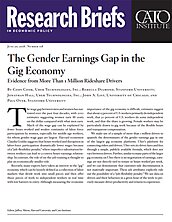Recently, many experts have taken an interest in the “gig” economy, which can be loosely defined as a collection of labor markets that divide work into small pieces and then offer those pieces of work to independent workers in real time with low barriers to entry. Although measuring the economic importance of the gig economy is difficult, estimates suggest that about 15 percent of U.S. workers primarily do independent work, that 30 percent of U.S. workers do some independent work, and that the share is growing. Female workers may be particularly drawn to gig work because of the flexible hours and transparent compensation.
We make use of a sample of more than 1 million drivers to quantify the determinants of the gender earnings gap in one of the largest gig economy platforms: Uber’s platform for connecting riders and drivers. Uber sets its driver fares and fees through a simple, publicly available formula, which does not vary between drivers. Further, similar to many parts of the larger gig economy, on Uber there is no negotiation of earnings, earnings are not directly tied to tenure or hours worked per week, and we can demonstrate that customer-side discrimination is not materially important. These job attributes explicitly rule out the possibility of a “job-flexibility penalty.” We use data on drivers and their behaviors in a given hour of the week to precisely measure driver productivity and returns to experience.
We find that men earn roughly 7 percent more per hour than women earn on average, which is in line with prior estimates of gender earnings gaps within specifically defined jobs. We can explain the entire gap with three factors. First, through the logic of compensating differentials, hourly earnings on Uber vary predictably by location and time of week, and men tend to drive in more lucrative locations. This occurrence is largely because male drivers tend to live near more lucrative locations and because men earn a compensating differential for their willingness to drive in areas with higher crime and with more drinking establishments.
The second factor is rideshare-specific human capital. Even in the relatively simple production of a passenger’s ride, past experience is valuable for drivers. A driver with more than 2,500 lifetime trips completed earns 14 percent more per hour than a driver who has completed fewer than 100 trips during her time on the platform, in part because she learns where and when to drive and how to strategically cancel and accept trips. Male drivers accumulate more experience than women by driving more each week and being less likely to stop driving with Uber. Because of these returns to experience and because the typical male driver on Uber has more experience than the typical female—putting male drivers higher on the learning curve—men earn more money per hour.
Third, we show that men do not earn more through greater work intensity. Controlling for accumulated hours of experience, drivers who work more hours in a given week earn less per hour. This finding suggests that policies that improve job flexibility (such as moving toward gig work) may have only a modest effect on the gender gap when the returns to experience are a key driver of the hour-earnings relationship.
We interpret these determinants of the gender pay gap—a propensity to gain more experience, choice of different locations, and higher speed—as preference-based characteristics that are correlated with gender and make drivers more productive. Although much prior work has also shown a relationship between the gap and factors that are likely to be related to preferences, we know of no prior work that fully decomposes the gender earnings gap in any setting.
Beyond measuring the gender earnings gap and unpacking it completely in an important labor market, our simple analysis provides insights into the roots of the gender earnings gap and the share of the pay gap that can be explained by each factor. First, driving speed alone can explain nearly half of the gender pay gap. Second, more than a third of the gap can be explained by on-the-job learning, a factor that is often almost impossible to evaluate in other contexts that lack high-frequency data on pay, labor supply, and output. The remaining gender pay gap can be explained by choices made over where to drive. Men’s willingness to supply more hours per week (enabling them to learn more) and to target the most profitable locations shows that women continue to pay a cost for working reduced hours each week. As the gig economy continues to grow, it will likely bring even more flexibility in earnings opportunities, which is valued by some, although not all, workers. However, the returns to experience and the temporal and geographic variation in worker productivity will likely persist and thus lead to a persistent gender earnings gap.
NOTE
This research brief is based on Cody Cook, Rebecca Diamond, Jonathan Hall, John A. List, and Paul Oyer, “The Gender Earnings Gap in the Gig Economy: Evidence from over a Million Rideshare Drivers,” Stanford University Graduate School of Business Working Paper no. 3637, January 2018, https://www.gsb.stanford. edu/faculty-research/working-papers/gender-earnings-gap-gigeconomy-evidence-over-million-rideshare.
